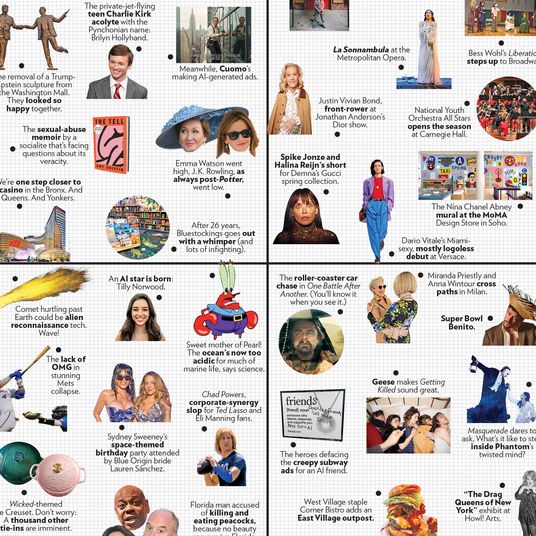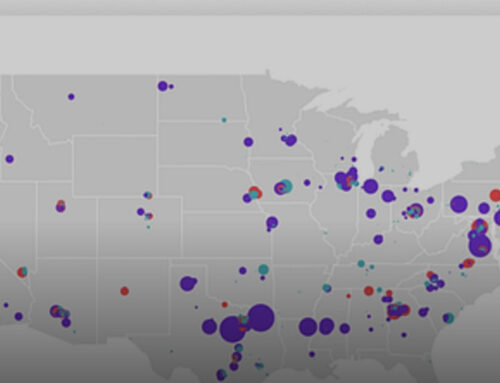Sora and the Sloppy Future of AI
October 5, 2025
OpenAI’s Sora, Meta’s Vibes, and the Sloppy Future of AI
5:00 A.M.

Photo-Illustration: Intelligencer; Photo: Sora

Photo-Illustration: Intelligencer; Photo: Sora
Last week, Meta’s newly appointed chief AI officer, Alexandr Wang, who co-founded the AI data-collection and annotation firm Scale.ai, announced Vibes, “a new feed in the Meta AI app for short-form, AI-generated videos.” Early responses were basically unanimous: What? Why? In testing, it felt, at most, like a chance to try out recent clip-generation tech for free. Otherwise, the feed was unfocused and confusing, full of overcooked generations by strangers unified only by the drab meta-aesthetics that have come to define AI imagery over the last couple of years: CGI-ish scenery and characters; real places and people rendered as uncanny stock photography; the work of Thomas Kinkade if he got into microdosing mushrooms. Even the more positive reviews couldn’t help but call it a feed of slop.
Photo: Vibes
In hindsight, though, the release of Vibes now makes a little more sense. Meta, which has been spending massive amounts of money to poach talent from other AI firms, probably knew a great deal about what OpenAI was about to release: a new version of its video-generation product, Sora, this time packaged as a TikTok-style app, dropped on Tuesday. In contrast with Vibes, Sora — an invite-only app with limited access — was an instant viral hit.
What’s the difference? Underlying models matter a little bit here. In an apparent rush to get the app out, and lacking better tech of its own, Meta ended up leaning on an outside image-and-video-generation company. Meanwhile, the latest OpenAI model is obviously more capable of producing what you ask it for, whether that’s a fairly realistic clip of a real person doing something normal, a jokey visual mash-up — or something stranger or more illicit, despite OpenAI’s attempts to include a wide range of guardrails. Early examples going around on social media included macabre or gross videos, the nonconsensual likenesses of public figures, and copyrighted characters. The Sora videos tended to feel either shockingly good, sort of grimy, or both (its own easily circumventable rules are notable, but as much as anything make it impossible to ignore the vastly more dire possibilities that already exist beyond the platform, courtesy of open and increasingly capable video-generation models).
What really made the app work, however, were two features. One encouraged users to create avatars of themselves, called Cameos, which could then be included in videos. The other was the ability to, with users’ permission, include their Cameos in your videos. Some of the first videos to get momentum on Sora were people making jokes about Sam Altman, commanding his avatar into various absurd, embarrassing, or simply unexpected situations.
Far more compelling, though, was to try Sora with people you know. If the sanctioned (and ultimately flattering) ritual of teasing OpenAI’s CEO with his own product as it harvested users’ likenesses defined early popular content, the experience of actually using the app was defined by stranger and more personal experiences. Oh, there’s a version of me, looking and sounding slightly wrong but uncomfortably familiar, operating at my command. Oh, I can include a friend in this one, and I can make him say or do whatever we want.
Sora, the model, is a tech demo. Sora, the feed, is an experiment tucked into a TikTok clone, only somewhat more interesting than Vibes. Sora, the consensual deep-fake automator, makes the most sense in the context of a group chat, or within the app in little-noticed interactions between friends. Messing around with your own avatar is unsettling, interesting, and entertaining, an in the queasy tradition of social-media face filters or those old apps that used “AI” to make you look old in exchange for your privacy. Messing around with the avatars of people you know, together, is startling and fun. Using Sora is a bit like dressing up as one another for Halloween: It’s easy to get a laugh and easy to go a little bit too far.
Photo: Sora
Sora is presumably extremely expensive to run, hence OpenAI’s use of a chained invite program to roll it out. In its early form, it brings to mind the early days of image generators like Midjourney, the video model for which Meta is now borrowing for Vibes. Like Sora, Midjourney in 2022, was a fascinating demo that was, for a few days, really fun to mess with for a lot of the same reasons:
A vast majority of the images I’ve generated have been jokes — most for friends, others between me and the bot. It’s fun, for a while, to interrupt a chat about which mousetrap to buy by asking a supercomputer for a horrific rendering of a man stuck in a bed of glue or to respond to a shared Zillow link with a rendering of a “McMansion Pyramid of Giza…”
…I still use Midjourney this way, but the novelty has worn off, in no small part because the renderings have just gotten better — less “strange and beautiful” than “competent and plausible.” The bit has also gotten stale, and I’ve mapped the narrow boundaries of my artistic imagination.
Playing with Sora is a similar experience: a destabilizing encounter with a strange and uncomfortable technology that will soon become ubiquitous but also rapidly and surprisingly banal. It also produces similar results: a bunch of generations that are interesting to you and your friends but look like slop to anyone else. The abundant glitches, like my avatar’s tendency to include counting in all dialogue, help make the generations interesting. Many of the videos that are compelling beyond the context of their creation are interesting largely as specimens or artifacts — that is, as examples of how a prompt (“sam altman mounted to the wall like a big mouth Billy bass, full body”) gets translated into … something. (As one friend noted, many of these videos become unwatchable if you can’t see what the prompt was.)
This makes Sora interesting to compare to more straightforwardly “social” networks, where most content is likewise produced for small audiences and lacks appeal beyond that context. Here, too, celebrities and brands are what people want to see, but with the expectation that they can be commanded and manipulated, not just consumed. Sora: It’s pretty fucking weird!
It’s also clearly compelling, and it (or imitations of it) are going to confront way more people — soon. OpenAI’s willingness to release strange, glitchy preview products (and to gleefully violate norms in the process) is at this point an established strategy and one that has reliably netted it users (in the case of ChatGPT, which now has hundreds of millions of users) or at least renewed attention (as when OpenAI demonstrated new image-generation tools through a viral aesthetic rip-off campaign). In terms of the AI “alignment” debate, for whatever it’s worth, the leading AI firm optimizing its product output for engagement is somewhere between “bad” and “apocalyptic.” It’s also something that Meta, despite its reputation for engagement-at-all-cost product design, can’t seem to pull off no matter how hard it tries.
In the broader discourse around what modern AI is for and where it might be going, it’s also useful to try to reconcile with some of the rhetoric from companies like OpenAI about why they need to raise so much money to build so many data centers. (For a glimpse of the view from within Google, see the above posts from people who work on AI there.) Are we trying to cure cancer? Obsolete knowledge workers? Build robots? Compete with Instagram? Buy some more runway? For now, the answer seems to be, “Hey, check out Sora, the app where you can make Sam Altman dance.”
Sora and the Sloppy Future of AI
Things you buy through our links may earn Vox Media a commission.
THE FEED

just asking questions
Peace in Gaza May No Longer Be a Fantasy
Israeli Policy Forum’s Michael Koplow says that while caveats abound, the new, Trump-brokered deal could really have legs.

social studies
Does It Matter What Your Therapist Thinks About Israel?
The war has divided Jewish New Yorkers from each other — and from their analysts.

we’ll do it live
House, Senate Locked in a Shutdown Stalemate: Live Updates
Trump shared a weird AI video starring him as the Grim Reaper as Congress continued informal talks. Welcome to day three.

early and often
The Other Demand Democrats Should Make During the Shutdown Fight
The real prize is winning the 2026 election, and there’s a Trump executive order standing in the way.

early and often
Trump Goes Over the Brink, Labels Democrats the Party of Satan
Aside from poisoning the atmosphere, Trump’s demonization of the opposition is a shout-out to the QAnon cult and “spiritual warriors.”

the approval matrix
The Approval Matrix: The Life of a One-Term Mayor
Our guide to what’s highbrow, lowbrow, brilliant, and despicable.

early and often
Trump Regards Millions of Americans As Enemies of the People
His sudden zest for mass layoffs of federal employees is another sign that Trump’s vengeance tour is taking in more territory every day.

early and often
Democrats Must Decide What It Means to Win a Shutdown Fight
They aren’t going to get everything they’re demanding. But Democrats can show they’re willing to fight and rehearse a midterms message.

the law
An Epic Courtroom Mismatch Is Looming in the Comey Case
A prosecutorial legend will be facing off against a (to put it kindly) fumbling beginner.

immigration
Why Did DHS Send a Russian Exile to Costa Rica?
How Trump’s third-country removal strategy forced an asylum-seeking family to start over — in Monteverde.

tremendous content
Why Did Melania Trump Share an AI Body-Double Video?: 4 Theories.
Is the First Lady’s bizarre X post an ad for her troubled cryptocurrency or confirmation of “fake Melania”?

politics
Is the Trump Administration’s Shutdown Messaging Illegal?
Federal-agency websites and federal workers’ email messages blame Democrats for the shutdown in a possible violation of the Hatch Act.

early and often
Trump’s 2024 Coalition Has Already Fallen Apart
Polls show Trump has lost the young, Black, and Latino supporters he attracted in 2024, leaving him with the same old white working-class base.

crime
Will Trump Pardon Diddy? What to Know Before the Sentencing.
The president said a pardon would be “difficult,” but also called his former friend “half innocent.”

early and often
It’s Hard to Fight McCarthyism When McCarthy Is President
Relaunching free-speech groups that fought the Red Scare is helpful. But last time, they had the White House as an ally, not an enemy.

politics
Ex-Staffer Claims Romance With Adams in Book, Odd AI Video
It hasn’t been the mayor’s greatest week.

just asking questions
The Dark Side Driving Pete Hegseth
It’s easy to make fun of his speech to generals, but it revealed deep, disturbing insecurities.

the city politic
The Mamdani Effect
Democrats seem to be acting differently since June. Is that a coincidence?

early and often
Vance Explains Trump’s Racist Shutdown Posts Are ‘Funny’
The AI videos of Hakeem Jeffries in a sombrero are actually hilarious (if you’re a rich white VP who won’t be furloughed).

early and often
How the Government Shutdown Will End
Republicans could erode Democratic unity, or Trump may cut a deal on Obamacare subsidies. Either way, an extremely long shutdown is likely.

early and often
Trump Is Tightening His Grip on State Republicans
His political machine is now bullying state lawmakers who won’t get onboard with his midterms-redistricting power grab.

screen time
AI’s Go-for-Broke Regulation Strategy
Companies like OpenAI wants to bend the law in one area, then use it as a liability shield in another.

immigration
The New Court Tactic Helping ICE Deport Immigrants
If the Trump administration gets its way, there will be more scenes of agents snatching people in hallways.

early and often
Trump’s New Core Mission for the Military: ‘Enemy Within’
In an alarming if incoherent speech to an assemblage of brass, the president puts the military on notice that America is a domestic battleground.
You’ll receive the next newsletter in your inbox.
*Sorry, there was a problem signing you up.
Search
RECENT PRESS RELEASES
Related Post



